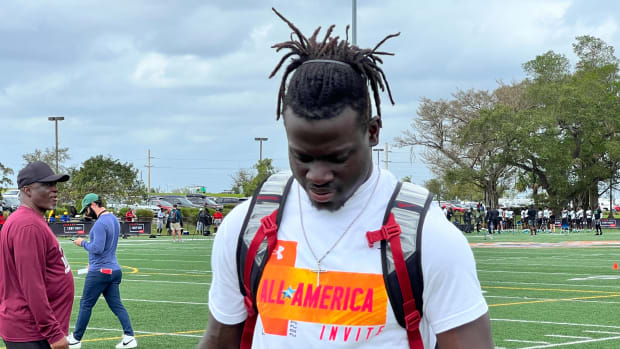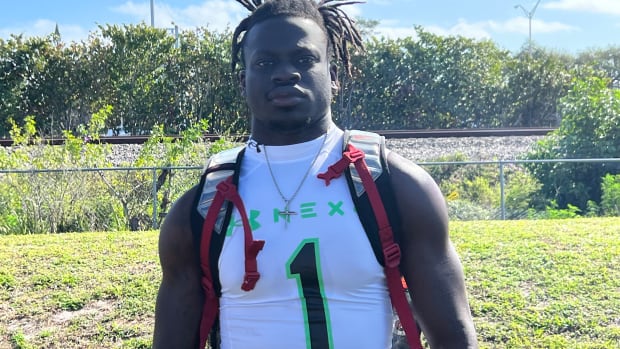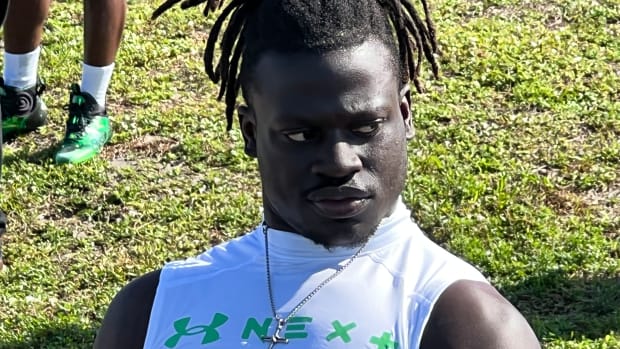Why Are Many Top Prospects Suddenly Not Coming to Under Armour Camps?
For any member of the media covering top prospects at Under Armour Camps this spring, there was a common conversation. Why isn’t (insert name) here?
The Under Armour Camp series is a lead-in to being invited to the Under Armour All-America Game. Elite players head to these camps, year after year, and media from all over the United States converge to see the talent compete against one another as they attempt to be invited to the All-Star game.
For a prospect like running back Richard Young from Lehigh Acres (Fla.) Lehigh, he wants competition above all else. He is seen on the cover photo of this article, competing at this year’s Under Armour Camp near Miami. It’s great that he still came and competed during every rep. He’s a “dude” and he still wanted to go against the best to get even better. There used to be several more elite players like Young at the Under Armour Camps.

Richard Young

Richard Young

Richard Young
Actually, for more than a decade during the late winter and early spring, the biggest collection of talent competing against each other at one location has come from the Under Armour Camps. Roughly 200 invite-only top prospects compete in a NFL-style combine and also do one-on-one reps like wide receivers versus defensive backs. It’s true competition. It’s also a way to see which top-notch performers do well when the cameras are on, a very important evaluation skill for everyone that watches and evaluates recruits.
There are different locations near major cities like Miami, Atlanta, and Dallas among others. 2022 was different despite the same locations holding Under Armour Camps. Compared to 2021, the list of elite players dwindled. The talent did not disappear, mind you, as the class of 2023, 2024 and even 2025 are very talented. That being said, numerous elite players suddenly did not show up to Under Armour Camps in 2022 like in previous years.
Why?
There could be many reasons for a few players missing the event like transportation or a person being sick. Fair enough. There could be some other reasons as well that are legitimate like a player simply just wanting to play in the Adidas All-Star Game (see more below) and not being interested in competing at an Under Armour Camp to get an invite to its All-America Game. That’s also a legitimate reason.
For those players that fall under either category, no worries. Is that all of them though? That’s not likely going to explain the vast number of players failing to show up like during prior years.
At the least, some prospects appear to be influenced by outside interests. Exactly how is hard to pinpoint, for now. That will not last long. Here’s a hint with a company that appears to be involved, but the specifics are just now being researched.
BREAKING: Adidas is opening its NIL network to every college athlete at an Adidas-partnered NCAA DI university.
— Front Office Sports (@FOS) March 23, 2022
The wide-sweeping NIL network is the first among major sports brands.
More than 50,000 athletes across 23 sports and 109 schools can become paid Adidas ambassadors. pic.twitter.com/T48jIeWteV
To be clear, NIL is not illegal. Well, depending on where one lives, their age, etc. It’s extremely complex. It’s like Pandora’s box. Depending on the state, high school athletes can make money off of NIL.
California is about the only one with a lot of players competing at a high level that’s very open to NIL from a state legislated perspective (so far). While that will likely change, any form of monies, gifts, etc. exchanged so that prospects wear gear, sponsor an event, etc. can lead to many issues, including but not limited to losing eligibility at the high school and college level.
It’s a really difficult area to discuss because again, it depends on the state in question. Still, the above tweet shows that this particular big shoe and apparel company, Adidas, is attempting to influence the decision of where top college athletes attend school.
Notice the part in the tweet that reads, "Adidas-partnered NCAA D1 university." It might as well read play for a school that makes Adidas money and we'll share a portion with you.
How that's legal, as it's an open inducement to influence the decision making of college football recruits, is quite questionable. It's also something else.
This is primarily about Adidas making a buck off of college athletes after influencing where they attend college. That’s nothing that has not been seen prior to now, but in different ways.
Paying recruits to sign a scholarship with a specific school has been a part of the underbelly of college athletics since as early as the 1970s and definitely in the 1980s. That money often came from companies like Adidas and Nike.
It’s been going on with the recruitment of top college basketball prospects for the better part of 50 years. Basketball payments and the scandals that ensued are common public knowledge, with many of them involving corporate apparel companies. Football has been less definitive with the shoe/apparel wars but it’s definitely looking like problems are headed for top football recruits as well. Here’s the potential rub for Adidas with this particular situation.
Many top players are suddenly not showing up to the Under Armour Camps, the same time and place that allows Under Armour representatives to invite top players to their All-America Game, first-hand.
Adidas would not have anything to do with that, would it? Keep in mind, Adidas has its All-American Bowl during January of each year just like Under Armour. Adidas hosts its event in San Antonio while Under Armour takes place in Orlando.
If Adidas is somehow just asking players to commit to their game and not attend Under Armour Camps, that’s not illegal. It's something else: pathetic and sad, definitely, as asking top players not to compete goes against the very nature of sport.
More importantly, the question is how would Adidas influence players not to even go to the Under Armour Camps where many players receive invites to the All-America Game? The following simply needs to be investigated further.
As of today, there’s no definitive proof of any wrongdoing. For anyone that’s covered elite high school prospects for several years or longer, however, it’s also well known that top prospects love to compete at Under Armour Camps. Numerous elite players suddenly not coming is a major red flag.
It just is.
When arguably 15, perhaps 20 of the top 40 players that were expected to be at any one of the Under Armour Camps do not show up, and it’s unexpected, there’s something going on.
Is there something illegal happening? Hard to say but foul play is nothing new with Adidas as the following AP story from 2017 details:
4 Coaches, Adidas Executives Arrested in College Bribe Scheme
When the FBI is involved, it’s not your normal story. Also, that particular three-letter acronym does not wait around for reporters to come by to snap pictures prior to hauling off future inmates. It’s more like, “Did you hear about so-and-so being arrested by the FBI?”
The FBI swoops in, arrests people, and it swoops out.
If there truly is any form of illegal pay/inducement for (non) play happening with regards to the Under Armour Camps or anything similar, it’s only a matter of time before something unfortunate happens with that three-letter acronym, the FBI, once again. That’s not all that can possibly go wrong for recruits in this situation or anything similar.
Same with the NCAA as they can strip eligibility in a moment’s notice if it believes financial influence takes place. It’s a potential big mess that few want to declare publicly but it’s fairly clear that it's already here. No reason to truly believe everything is 100% above board. What happened with the basketball shoe wars has all but assuredly crossed over into prep football level. Moving forward, there needs to be more monitoring, more investigating.
Further, adults with the actual best interests of these players need to be keeping an eye on them. They need to make sure that nothing ends up happening to teenagers that’s not only illegal and costs them college scholarships, but possibly causes their reputation to be tarnished and ruins a chance at playing in the NFL. That would be just sad. The FBI does not care. It does what it does and that’s that. The NCAA is another animal of its own.
The NCAA is all over the map with its sanctions of players and its member schools, but it’s certainly plausible that it could cost players eligibility as well. Just hard to say what might happen with the NCAA.
It’s going to be interesting to see what ensues from this point forward, especially with the gray area of NIL being a way that a major shoe brand could possibly funnel money to prospects so that they attend specific college football programs that are also sponsored by the same apparel company.
